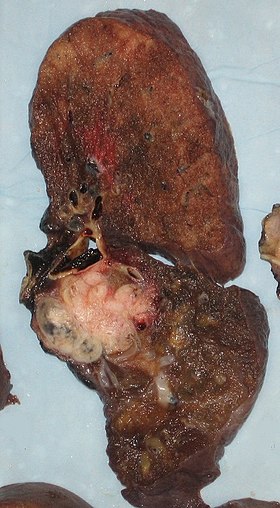Pneumonectomy
| Pneumonectomy | |
|---|---|
 Appearance of the cut surface of a pneumonectomy specimen containing lung cancer, here a squamous cell carcinoma (the whitish tumor near the bronchi). | |
| ICD-9-CM | 32.5 |
| MeSH | D011013 |
A pneumonectomy (or pneumectomy) is a surgical procedure to remove a lung first successfully done in 1933 by Dr. Evarts Graham. This is not to be confused with a lobectomy or segmentectomy, which only removes one part of the lung.
There are two types of pneumonectomy, simple and extra pleural. A simple pneumonectomy removes just the lung. An extra pleural pneumonectomy take away part of the diaphragm, the parietal pleura, and the pericardium on that side as well.[1]
Indications
The most common reason for a pneumonectomy is to remove tumourous tissue arising from lung cancer. Other reasons can arise are a traumatic lung injury, bronchiectasis, tuberculosis, a congenital defect, and fungal infections.[2]
Contraindications
Tests
The operation will reduce the respiratory capacity of the patient and before conducting a pneumonectomy, survivability after the removal has to be assessed. If at all possible, a pulmonary function test (PFT) should be done prior. It has been found that forced expiratory volume in one second (FEV1) and diffusion capacity of the lungs (DLCO) provides the best indicator of survival.[3] Other tools can be used to assess effectiveness as well such as cardiopulmonary exercise testing to measure maximal oxygen consumption (Vo(2) max), stair climbing, shuttle walk test, and a 6-min walk test[4]
Pathologies
If someone has severe valvular disease, severe pulmonary hypertension, or poor ventricular function or if cancer has spread from the lungs into the other intra-abdominal structures, ribs, or contralateral hemithorax, it is contraindicated.[5]
Anatomical Changes
After a pneumonectomy is performed changes in the thoracic cavity occur to compensate for the altered anatomy. The remaining lung hyperinflates as well as shifting over along with the heart towards the now empty space. This space is full of air initially after surgery, but then it is absorbed and fluid eventually takes its place.[6]

History

Pioneering dates
- 1895: first pneumonectomy in multiple stages by William Macewen on a patient with tuberculosis and emphysema
- 1912: first anatomical dissection lobectomy by Hugh Morriston Davies[7]
- 1918: first successful lobectomy, by Harold Brunn[8]
- 1931: first successful pneumonectomy in two stages by Rudolph Nissen on a patient with crush injury to the thorax
- 1933: first successful single-stage total pneumonectomy by Graham and Singer[9]
- 1939: first segmentectomy, by Churchill and Belsey[10]
See also
References
- ^ Opitz I, Weder W (June 2017). "A nuanced view of extrapleural pneumonectomy for malignant pleural mesothelioma". Annals of Translational Medicine. 5 (11): 237. doi:10.21037/atm.2017.03.88. PMC 5497104. PMID 28706905.
{{cite journal}}: CS1 maint: unflagged free DOI (link) - ^ "Pneumonectomy". www.hopkinsmedicine.org. 2019-11-19. Retrieved 2022-11-09.
- ^ Brunelli, Alessandro; Kim, Anthony W.; Berger, Kenneth I.; Addrizzo-Harris, Doreen J. (May 2013). "Physiologic evaluation of the patient with lung cancer being considered for resectional surgery: Diagnosis and management of lung cancer, 3rd ed: American College of Chest Physicians evidence-based clinical practice guidelines". Chest. 143 (5 Suppl): e166S–e190S. doi:10.1378/chest.12-2395. ISSN 1931-3543. PMID 23649437.
- ^ Colice, Gene L.; Shafazand, Shirin; Griffin, John P.; Keenan, Robert; Bolliger, Chris T.; American College of Chest Physicians (September 2007). "Physiologic evaluation of the patient with lung cancer being considered for resectional surgery: ACCP evidenced-based clinical practice guidelines (2nd edition)". Chest. 132 (3 Suppl): 161S–77S. doi:10.1378/chest.07-1359. ISSN 0012-3692. PMID 17873167.
- ^ Fleisher, Lee A.; Beckman, Joshua A.; Brown, Kenneth A.; Calkins, Hugh; Chaikof, Elliot L.; Chaikof, Elliott; Fleischmann, Kirsten E.; Freeman, William K.; Froehlich, James B.; Kasper, Edward K.; Kersten, Judy R.; Riegel, Barbara; Robb, John F.; Smith, Sidney C.; Jacobs, Alice K. (2007-10-23). "ACC/AHA 2007 Guidelines on Perioperative Cardiovascular Evaluation and Care for Noncardiac Surgery: Executive Summary: A Report of the American College of Cardiology/American Heart Association Task Force on Practice Guidelines (Writing Committee to Revise the 2002 Guidelines on Perioperative Cardiovascular Evaluation for Noncardiac Surgery) Developed in Collaboration With the American Society of Echocardiography, American Society of Nuclear Cardiology, Heart Rhythm Society, Society of Cardiovascular Anesthesiologists, Society for Cardiovascular Angiography and Interventions, Society for Vascular Medicine and Biology, and Society for Vascular Surgery". Journal of the American College of Cardiology. 50 (17): 1707–1732. doi:10.1016/j.jacc.2007.09.001. ISSN 1558-3597. PMID 17950159.
- ^ Beshara, Michael; Bora, Vaibhav (2022), "Pneumonectomy", StatPearls, Treasure Island (FL): StatPearls Publishing, PMID 32310429, retrieved 2022-11-09
- ^ Naef, A (1993). "Hugh Morriston Davies: First Dissection Lobectomy in 1912". Annals of Thoracic Surgery. 56 (4): 988–989. doi:10.1016/0003-4975(93)90377-t. PMID 8215687. Archived from the original on 2013-07-04.
- ^ Rosenthal, R; Zenilman M (2001). Principles and Practice of Geriatric Surgery. Springer. p. 393. ISBN 9780387983936.
- ^ Horn, L; Johnson DH (July 2008). "Evarts A. Graham and the first pneumonectomy for lung cancer". Journal of Clinical Oncology. 26 (19): 3268–3275. doi:10.1200/JCO.2008.16.8260. PMID 18591561. Archived from the original on 2020-03-17. Retrieved 2009-03-21.
- ^ Churchill, E; Belsey R (1939). "Segmental Pneumonectomy in Bronchiectasis: The Lingula Segment of the Left Upper Lobe". Annals of Surgery. 109 (4): 481–499. doi:10.1097/00000658-193904000-00001. PMC 1391296. PMID 17857340.
External links
- Fuentes PA (April 2003). "Pneumonectomy: historical perspective and prospective insight". Eur J Cardiothorac Surg. 23 (4): 439–45. doi:10.1016/s1010-7940(03)00117-9. PMID 12694756.
